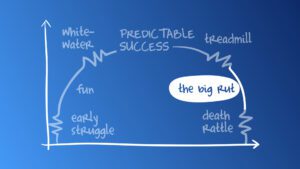Big Rut is the second to last stage in the Predictable Success lifecycle. While the Big Rut doesn’t sound like something any of us want to put our business in, there are many once-great businesses, organizations, and institutions that have done precisely that. And truth be told, I doubt any of them mind. This is because they have all fallen prey to the same problem.
They have lost the ability to self-diagnose and don’t even realized something is wrong.
Leaders in organizations in the Big Rut think they’ve finally gotten things figured out. They may reach their peak profitability in the Big Rut; we’ll talk about why that is actually a bad sign later in the article. When they enter the Big Rut, they are still growing, at least from a numbers standpoint. They usually have great little innovation departments that are creating new versions of the same thing, and though uninspired, they still sell well. Things are great. They mistakenly believe this smooth sailing is Predictable Success. They are fooled into believing they are at the top of their game.
Another name you could use for this stage is “The Lie.”
These organizations are nowhere near Predictable Success. The Visionary is long gone, and in fact, all they are doing is living off yesteryear’s hard work. Having been through Predictable Success there is plenty to live off of for a while. Just long enough to lull the leadership to sleep.
While on the model, this looks like a steep fall. The organization likely amassed a war chest of balance sheets and built a recognizable and reputable brand that the market trusts almost without question. Big Rut companies can ride this momentum for a long time without ever realizing they aren’t moving upward; they are actually on a long, slow slide into irrelevancy.
[bctt tweet=”Big Rut companies can ride this momentum for a long time without ever realizing they aren’t moving upward; they are actually on a long, slow slide into irrelevancy. ” username=”8figurefocus”]
How did we get here
An organization moves into the Big Rut if it fails to course correct in Treadmill. Treadmill is a sort of the last stand for the Visionary leadership style within an organization. The visionary style will reignite risk-taking, ingenuity, and innovation or burn out and be replaced by a cheap replica.
The language of innovation replaces the work of innovation. The creation of value for tomorrow is replaced by the much safer, much more efficient extraction of value from yesterday.
Once this tension is put to rest, a false sense of balance takes over. Often, many red flags are waved. Revenue increases when attention is turned away from new ventures and focused on the organization’s existing business. Profit increases because the organization stops exploring and stops failing. Even the culture improves as uniformity is increasingly embraced. The organization is increasingly staffed by Processors and Synergists who excel at keeping the trains running on time and all the passengers happy.
But none of this can last. While the resource-rich organization is living off the past, some new upstart organization is working tirelessly to change things. While many of these idealistic startups will fail, it is only a matter of time before one figures it out, strikes gold, and disrupts the big players or even the entire industry.
There’s only one way out
The worst part, the real tragedy of all of this, is there is no going back. Not with the current leaders and probably not with the current product/service offering. The organization, at this point, is simply too far gone. Too set in their ways to change and too apathetic to care, they can’t keep up.
Though they will consistently deny this threat, the truth is, there’s only one way out of the Big Rut, and that is to reach the seventh and final stage in the Predictable Success lifecycle, Death Rattle.
Wrapping it up
If you are reading this article, it is highly unlikely that you are leading a business in the Big Rut. You are more likely to be a Visionary feeling the pain of Treadmill, or someone deeper in the organization frustrated. You can clearly see what is happening and cannot understand why management doesn’t see it.
In either case, you are right to see that something is wrong. And in either case, you may want to consider starting a new business of your own. Most founders leave well-paying jobs for this very reason. Maybe you’re next.
If you think you are in Big Rut but aren’t quite sure, I’d like to encourage you to take the free Lifecycle assessment at https://bit.ly/Lifecycle-Quiz to find out for sure and to see around the corner at what is next for your business!
[yotuwp type=”playlist” id=”PLNTSkWehajGO0CN_5aj5uTwLXGRKzW_Ny” ]


 ReIgnite Your Treadmill Organization Post COVID-19
ReIgnite Your Treadmill Organization Post COVID-19